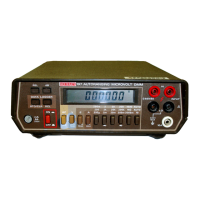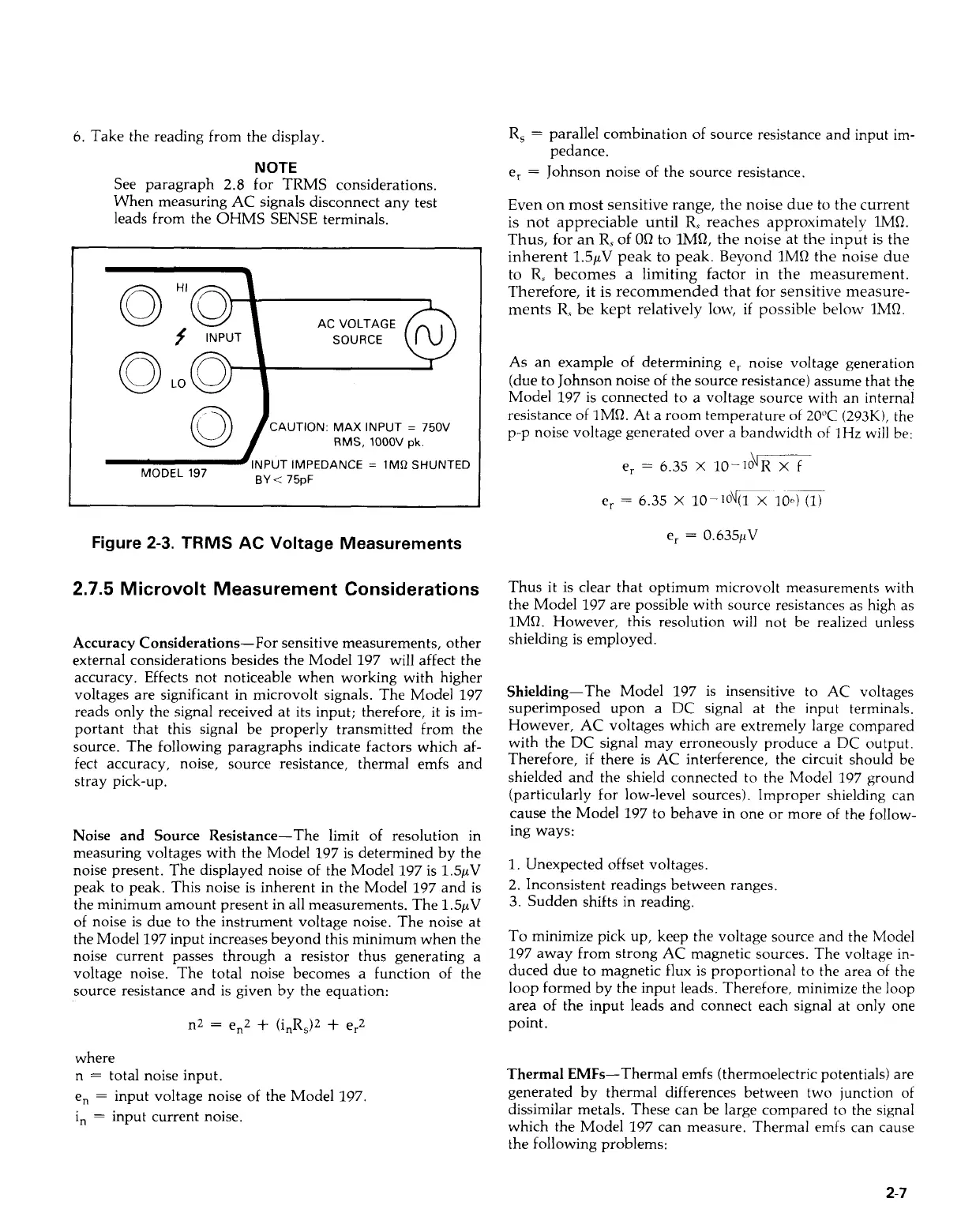6. Take the reading from the display
NOTE
See paragraph
2.8
for TRMS considerations.
When measuring
AC
signals disconnect any test
leads from the OHMS SENSE terminals.
-INPUT
IMPEDANCE
=
IMR
SHUNTED
BY
<
75pF
MODEL
197
R,
=
parallel combination of source resistance and input im-
e,
=
Johnson noise of the source resistance.
pedance.
Even
on
most sensitive range, the noise due to the current
is
not appreciable until R, reaches approximately
lMQ.
Thus, for an R, of
OQ
to
lMQ,
the noise at the input is the
inherent 1.5pV peak to peak. Beyond
1MQ
the noise due
to R, becomes a limiting factor in the measurement.
Therefore, it is recommended that
for
sensitive measure-
ments R, be kept relatively 10~7,
if
possible below
1MQ.
As
an example of determining e, noise voltage generation
(due to Johnson noise of the source resistance) assume that the
Model 197 is connected to a voltage source with an internal
resistance of
1MQ.
At
a
room temperature
of
20°C
(293K),
the
p-p noise voltage generated over a bandwidth
of
1Hz
will be:
e,
=
6.35
X
10-10
\J
R
X
f
e,
=
6.35
X
lO-lO\r(lx
10m
Figure
2-3.
TRMS
AC
Voltage Measurements
e,
=
0.635pV
2.7.5
Microvolt Measurement Considerations
Accuracy Considerations-For sensitive measurements, other
external considerations besides the Model
197
will affect the
accuracy. Effects not noticeable when working with higher
voltages are significant in microvolt signals. The Model 197
reads only the signal received at its input; therefore,
it
is im-
portant that this signal be properly transmitted from the
source. The following paragraphs indicate factors which af-
fect accuracy, noise, source resistance, thermal emfs and
stray pick-up.
Noise and Source Resistance-The limit of resolution in
measuring voltages with the Model 197 is determined by the
noise present. The displayed noise of the Model 197 is 1.5pV
peak to peak. This noise is inherent in the Model 197 and is
the minimum amount present in all measurements. The 1.5pV
of noise is due to the instrument voltage noise. The noise at
the Model 197 input increases beyond this minimum when the
noise current passes through a resistor thus generating a
voltage noise. The total noise becomes a function of the
source resistance and is given by the equation:
n2
=
en2
+
(inRs)2
+
er2
where
n
=
total noise input.
en
=
input voltage noise of the Model 197.
in
=
input current noise.
Thus
it
is clear that optimum microvolt measurements with
the Model 197 are possible with source resistances as high as
1MQ.
However, this resolution will not be realized unless
shielding is employed.
Shielding-The Model 197 is insensitive
to
AC
voltages
superimposed upon a
DC
signal at the input terminals.
However,
AC
voltages which are extremely large compared
with the
DC
signal may erroneously produce
a
DC
output.
Therefore,
if
there is
AC
interference, the circuit should be
shielded and the shield connected to the Model 197 ground
(particularly for low-level sources). Improper shielding can
cause the Model 197 to behave in one
or
more of the follow-
ing ways:
1. Unexpected offset voltages.
2.
Inconsistent readings between ranges.
3.
Sudden shifts in reading.
To minimize pick up, keep the voltage source and the Model
197 away from strong
AC
magnetic sources. The voltage in-
duced due to magnetic flux is proportional to the area
of
the
loop formed by the input leads. Therefore, minimize the loop
area of the input leads and connect each signal at only one
point.
Thermal EMFs-Thermal emfs (thermoelectric potentials) are
generated by thermal differences between two junction
of
dissimilar metals. These can be large compared
to
the signal
which the Model 197 can measure. Thermal emfs can cause
the following problems:
2-7
Artisan Technology Group - Quality Instrumentation ... Guaranteed | (888) 88-SOURCE | www.artisantg.com

